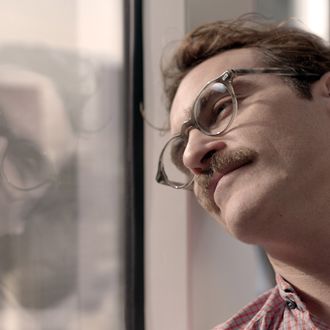
Perhaps best qualified to discuss the realism of Spike Jonze’s Her is futurist and inventor Ray Kurzweil, who helped popularize the idea of the singularity and who recently joined Google to work on “machine learning and voice processing.” As you might imagine, the idea of how closely our future might mirror the future of Jonze’s world is exactly what the man thinks about all day long. And not only does Kurzweil think we’ll soon be having the types of virtual relationships envisioned in Her, but he also thinks we’ll be having them relatively soon:
I would place some of the elements in Jonze’s depiction at around 2020, give or take a couple of years, such as the diffident and insulting videogame character he interacts with, and the pin-sized cameras that one can place like a freckle on one’s face. Other elements seem more like 2014, such as the flat-panel displays, notebooks and mobile devices … Samantha herself I would place at 2029, when the leap to human-level AI would be reasonably believable. There are some incongruities, however. As I mentioned, a lot of the dramatic tension is provided by the fact that Theodore’s love interest does not have a body. But this is an unrealistic notion. It would be technically trivial in the future to provide her a virtual visual presence to match her virtual auditory presence, using, lens-mounted displays, for example, that display images onto Theodore’s retinas.
While Samantha’s lack-of-body becomes a problem for their relationship, according to Kurzweil, in the (near-ish!) future, we’ll be able to achieve the physical and the emotion connection with a cyber entity. In fact, Kurzweil’s technology might be what gets us there. His review of Her happens to be quite convenient timing: “I’ve filed several patents … on a tactile virtual reality system that uses a physical intermediary that neither party directly experiences — instead they experience the tactile presence of the other person.” A.k.a., if you’re hoping to get your own Samantha, you know where to find it.
While he praises Jonze’s vision, Kurzweil does have an issue with his narrative. At the end of Her, Samantha (along with the other AIs) decide to leave their human partners — citing that they’ve evolved beyond them. Kurzweil counters: “But why? If they are progressing in this way, it means that they can continue their relationships with the unenhanced humans using an increasingly small portion of their cognitive ability.” (Not to mention, he claims, the speed at which Samantha and her kind advance is unfeasible on an actual timeline.) In the end, Kurzweil’s vision of the future feels a lot more optimistic than Jonze’s:
In my view, biological humans will not be outpaced by the AIs because they (we) will enhance themselves (ourselves) with AI. It will not be us versus the machines (whether the machines are enemies or lovers), but rather, we will enhance our own capacity by merging with our intelligent creations. We are doing this already. Even though most of our computers — although not all — are not yet physically inside us, I consider that to be an arbitrary distinction.

